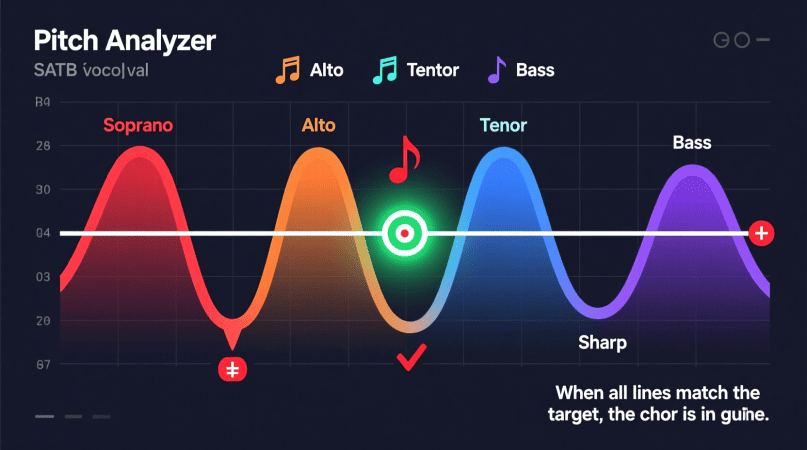
Singing in a choir means blending voices into one unified sound. But intonation — staying in tune with the group — is often the hardest part. The Voice Pitch Analyzer helps choirs improve pitch accuracy, blending, and tuning consistency in real time.
This guide shows you how to use the analyzer for choir practice, from warm-ups to group intonation drills.
Why Intonation Matters in Choirs
- Blend: Unified pitch makes harmonies sound rich and smooth.
- Balance: Prevents individual voices from standing out or going flat/sharp.
- Confidence: Singers hear, see, and learn correct pitch faster.
With the Voice Pitch Analyzer, each singer gets instant visual feedback on their pitch accuracy, measured in ±cents.
How to Set Up for Choir Practice
- Open the Tool: Voice Pitch Analyzer on a laptop or tablet.
- Position the Microphone: Place a condenser mic near the front row for group checks.
- Quiet Environment: Practice in a room with minimal echo for best accuracy.
- Project Pitch Readings: Display the screen so singers see pitch feedback in real time.
Group Warm-Up Routine
1. Unison Pitch Holds
- Sing one note (e.g., A4) together.
- Hold for 3–5 seconds while watching the ±cents meter.
- Goal: Keep readings near 0–5¢ for all singers combined.
2. Scale Practice
- Sing ascending/descending scales in unison.
- Pause briefly on each note until readings stabilize.
- Helps build interval consistency across the choir.
3. Harmony Check
- Divide into two groups: one holds a root note, the other sings a third or fifth.
- Use the analyzer to confirm both parts stay in tune relative to each other.
Intonation Exercises for Blending
| Exercise Name | Purpose | Instructions |
|---|---|---|
| Unison Centering | Pitch stability | Hold single note, aim for 0–5¢ range |
| Interval Harmony | Harmony intonation | Root & third/fifth balance |
| Moving Intervals | Smooth transitions | Shift notes together, watch stability |
| Crescendo Blending | Volume & pitch balance | Increase volume without drifting pitch |
| Soft Voice Accuracy | Low-volume tuning | Practice pianissimo passages clearly |
For additional individual pitch exercises, see Singing Pitch Accuracy Exercises.
Common Problems & Fixes
- Sharp on high notes: Practice slowly with controlled breath support.
- Flat endings: Hold final notes longer, watching ±cents readings closely.
- Flickering pitch display: Read Pitch Flicker: 9 Causes & Fixes for setup tips.
FAQs
1. Can the analyzer handle multiple singers?
Yes, but group readings work best with unison or simple harmony passages.
2. Should each singer use their own device?
Optional. Group practice works on one device; individual devices help with personal training.
3. Does room acoustics matter?
Yes. Less echo = more accurate readings.
4. Is this useful for virtual choirs?
Yes, singers can practice individually at home before online recordings or rehearsals.
Pitch Detector is a project by Ornella, blending audio engineering and web technology to deliver precise, real-time pitch detection through your browser. Designed for musicians, producers, and learners who want fast, accurate tuning without installing any software.
